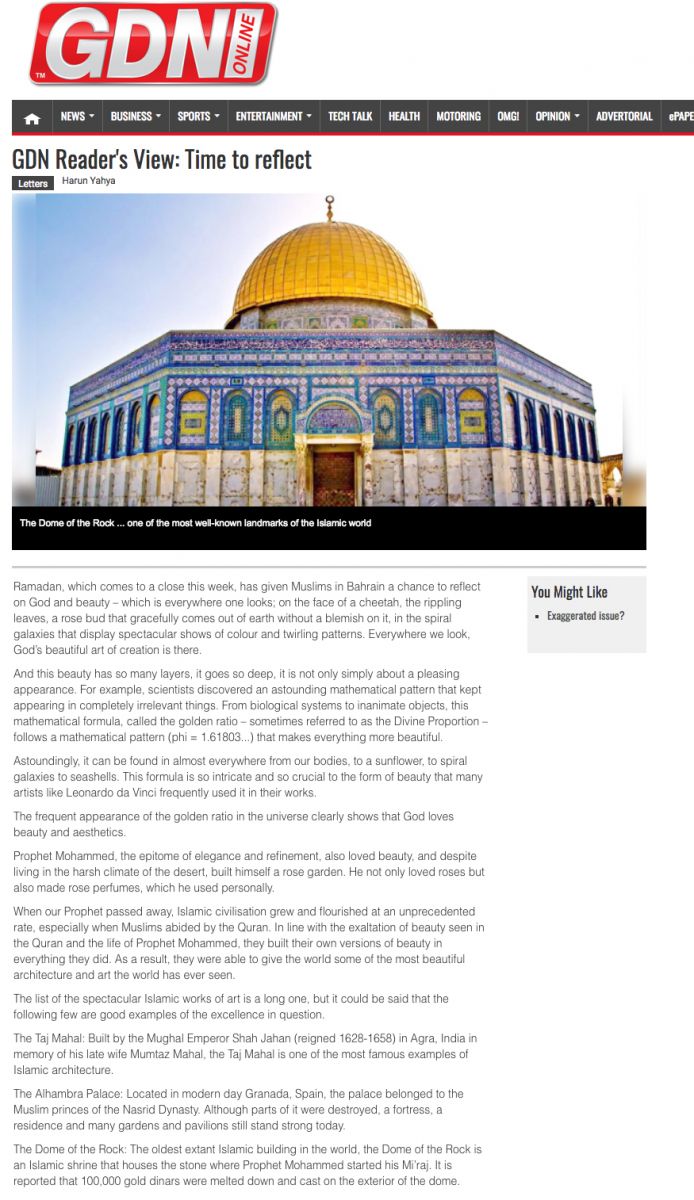Bigotry: The Dark Danger
Time to reflect

Ramadan, which comes to a close this week, has given Muslims in Bahrain a chance to reflect on God and beauty – which is everywhere one looks; on the face of a cheetah, the rippling leaves, a rose bud that gracefully comes out of earth without a blemish on it, in the spiral galaxies that display spectacular shows of colour and twirling patterns. Everywhere we look, God’s beautiful art of creation is there.
And this beauty has so many layers, it goes so deep, it is not only simply about a pleasing appearance. For example, scientists discovered an astounding mathematical pattern that kept appearing in completely irrelevant things. From biological systems to inanimate objects, this mathematical formula, called the golden ratio – sometimes referred to as the Divine Proportion – follows a mathematical pattern (phi = 1.61803...) that makes everything more beautiful.
Astoundingly, it can be found in almost everywhere from our bodies, to a sunflower, to spiral galaxies to seashells. This formula is so intricate and so crucial to the form of beauty that many artists like Leonardo da Vinci frequently used it in their works.
The frequent appearance of the golden ratio in the universe clearly shows that God loves beauty and aesthetics.
Prophet Mohammed, the epitome of elegance and refinement, also loved beauty, and despite living in the harsh climate of the desert, built himself a rose garden. He not only loved roses but also made rose perfumes, which he used personally.
When our Prophet passed away, Islamic civilisation grew and flourished at an unprecedented rate, especially when Muslims abided by the Quran. In line with the exaltation of beauty seen in the Quran and the life of Prophet Mohammed, they built their own versions of beauty in everything they did. As a result, they were able to give the world some of the most beautiful architecture and art the world has ever seen.
The list of the spectacular Islamic works of art is a long one, but it could be said that the following few are good examples of the excellence in question.
The Taj Mahal: Built by the Mughal Emperor Shah Jahan (reigned 1628-1658) in Agra, India in memory of his late wife Mumtaz Mahal, the Taj Mahal is one of the most famous examples of Islamic architecture.
The Alhambra Palace: Located in modern day Granada, Spain, the palace belonged to the Muslim princes of the Nasrid Dynasty. Although parts of it were destroyed, a fortress, a residence and many gardens and pavilions still stand strong today.
The Dome of the Rock: The oldest extant Islamic building in the world, the Dome of the Rock is an Islamic shrine that houses the stone where Prophet Mohammed started his Mi’raj. It is reported that 100,000 gold dinars were melted down and cast on the exterior of the dome. When it was first built, it was said that it “had so strong a gleam, no eye could look straight at it”. It is today one of the most well-known landmarks of the Islamic world.
As mentioned before, the list Islamic of architectural masterpieces is a long one. However, they all have one thing in common; a desire to show an appreciation for God’s art of creation as much as a desire to build something beautiful that will befit the beauty of God’s creation.
Adnan Oktar's piece in Gulf Daily News:
http://www.gdnonline.com/Details/367240/GDN-Readers-View-Time-to-reflect
2018-06-19 18:24:45






